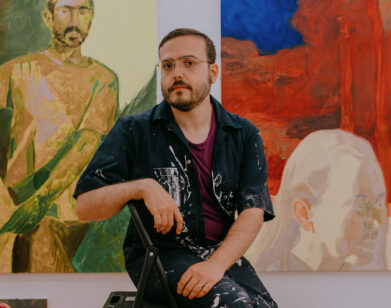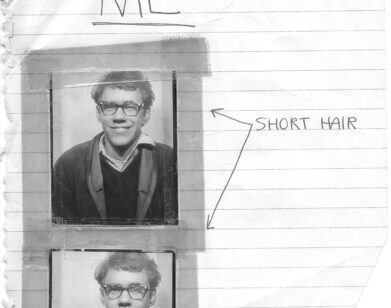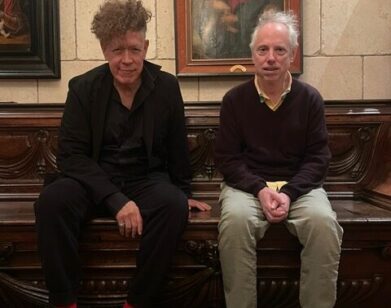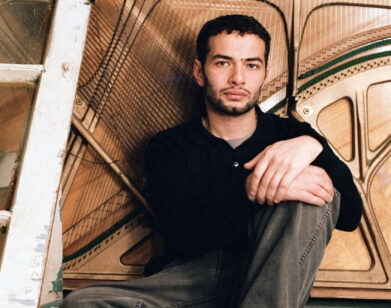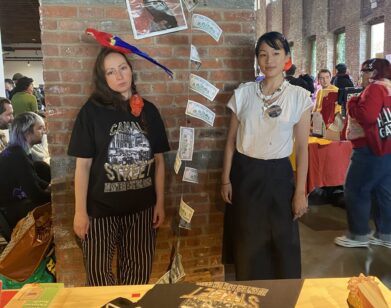Josh Smith
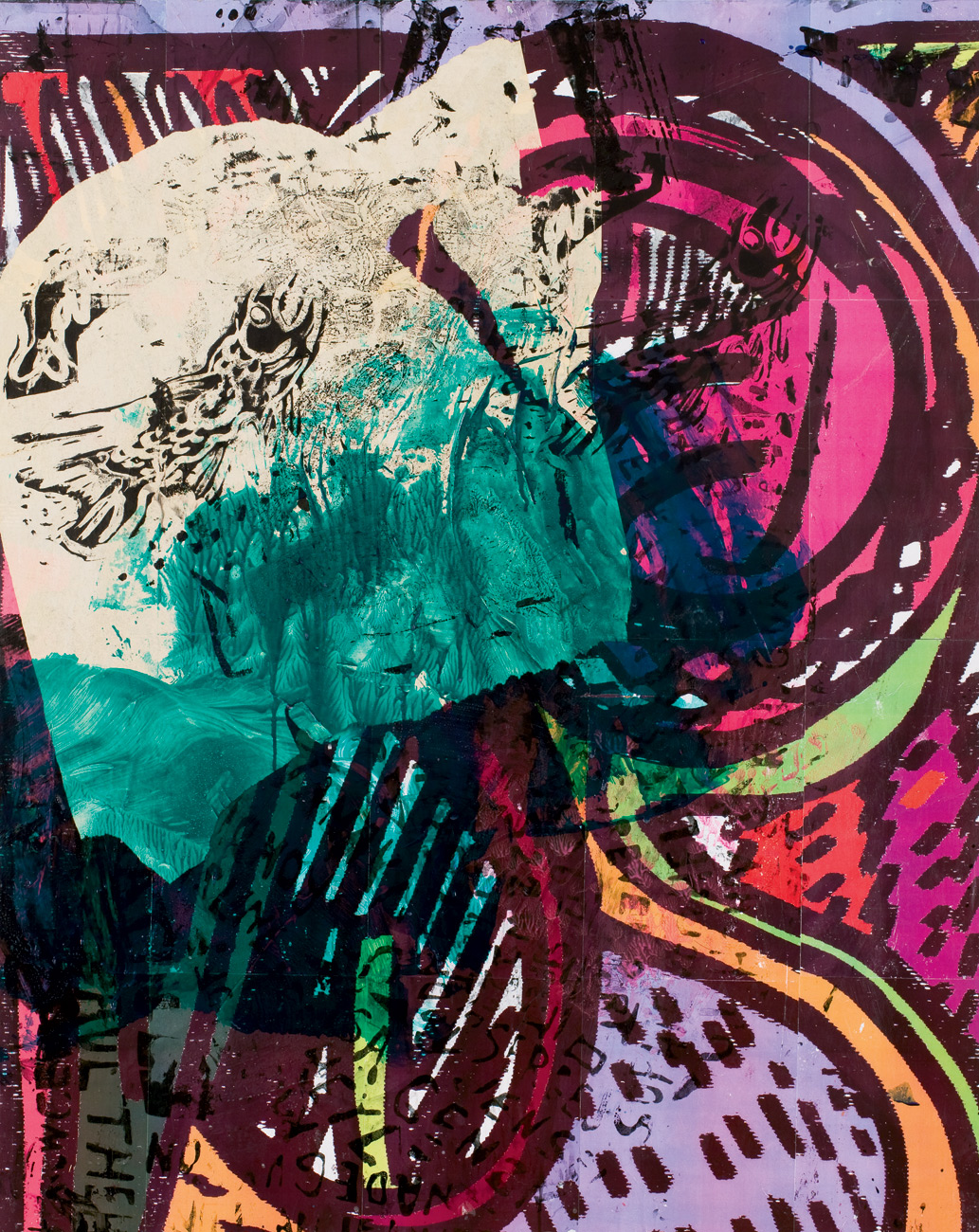
By now, the artist Josh Smith’s practice of turning his signature into the subject of his frenetic oil paintings is familiar. Rendered in quick, colorful dashes, sometimes piled on top of each other is J-O-S-H-S-M-I-T-H written across the canvas, looking half like a vandal’s tag and half like the distinction and hero-worship reserved for the great masters. In fact, so much has been made about the 35-year-old Tennessee-born painter’s signa- ture (Is he a narcissist? Is he turning the subject into an object? Is he taking the piss out of portraiture?) that it’s easy to forget that Smith paints a number of other subjects (fish, leaves) and includes collaged materials (newspapers, photocopies, prints) in his layered works as well. Earlier this spring, though, Smith brought his signature back into the gallery with a solo show at Luhring Augustine in New York City, literally shining a spotlight on it on a sculptural stage set, while paintings of insects and skeletons covered the walls. Here “Josh Smith” was being connected with death—death, by the way, rendered in bright, acid-fueled colors, has never looked better—and also with the eerie immortality of fame.
Smith’s aggressive, fast-and-furious painting style belies the fact that he works very strategically and methodically. His unusual ethic will be further explored this month when a new exhibition opens on May 7 at the Brant Foundation Art Study Center in Greenwich, Connecticut. For the show, artists Urs Fischer (who Smith knew previously) and Julian Schnabel (who Smith did not) will serve as consultants. Under their “consultancy,” Smith is considering on mixing works (his and also perhaps others) from the Brant collection with new pieces created on site in the few weeks before the opening. In a way, it’s the perfect Smithian mash-up. Here he talks to his good friend and fellow Tennessean Harmony Korine about being an artist—and the struggles that lie therein.
HARMONY KORINE: What’s up, motherfucker? Josh Smith in the building. Josh Smith is the new Mike Jones. [both laugh] I just saw your show at Luhring Augustine. Where did the ideas come from for those paintings?
JOSH SMITH: It’s three disparate elements: the stop sign, the stage paintings, and the skeleton paintings. Those are three sharp ideas, although none of them are necessarily good ideas. Tons of artists have made whole careers out of those three ideas.
KORINE: Tell me about the stop signs.
SMITH: It’s the ultimate conceptual artwork. I took a piece of metal and just painted an image of a stop sign on it—a four-by-four-foot stop sign.
KORINE: Did you make them all by hand?
SMITH: I tried to do it, but it’s easier to use a stencil. I didn’t want it to have any technical virtuosity; I wanted it to just be really clear how it was made. For my work in general, it’s always really clear how it is made.
KORINE: We both grew up in Tennessee. I remember all the stop signs by my house were riddled with bullet holes—or BB holes.
SMITH: Oh, yeah. And the cool kids always had a stop sign in their bedroom. Which means: “I don’t care if people die. I want my stop sign.” At least the assumption was that they took it down from somewhere and now there are old ladies hitting each other head-on somewhere.
KORINE: Did you ever think about making stop signs with bullet holes?
SMITH: I’m sure somebody else will. I generally just do a really rough thing and then everybody else does it more detailed.
KORINE: The stage sculptures in your show were my favorite. For me, they were just so out there.
SMITH: It’s a stage with four lights clamped to it with walls made out of plywood. And then my name’s in the center. It’s the type of thing that can be made over and over again. It’s not like a Michelangelo sculpture.
KORINE: And you have these four lights beaming down almost like a spotlight on your name.
SMITH: I have a streak in myself, like, I’m an exhibi- tionist. There’s a side of me that really wants to show off and share parts of myself with others. I mean, that’s why I live in New York, and that’s why I’m an artist who shows 10 times a year.
KORINE: You like showing your art. You want people to see your work.
SMITH: Yeah, I think any asshole who’s here and who pretends they don’t like shit like that should leave. They’re a liar. They should go back to where they came from and open up an arts-and-crafts store.
KORINE: Is it fun for you when people see your work and get upset or say bad things about it?
SMITH: No, I respect that. I like when people have opinions—especially about art. You can hate my art. I made my art to be hated. That’s why I made the name paintings. So rather than someone coming to my stu- dio and saying, like, “Thank you for your time. I’ll see you later,” and me not knowing why they don’t like my work, I understand now why they don’t like it. I made work specifically for them not to like. If you made paintings of flowers and someone says they hate it, it’s like, “What do you mean? It’s a flower!” But if you make a painting of your name and somebody says they hate it, it’s like, “Well, why would you like a painting of my name anyway?”
KORINE: I want to hear about the name paintings. It’s really become one of your signatures. Where did it come from?
SMITH: Everything comes from a weird place that I don’t understand. I make a piece of art just to prove that I exist in my own way. And I can’t make something nice. I have to make something that makes me uncomfortable.
KORINE: Do you think that you’re going to keep making them forever?
SMITH: I hope so. That was always the idea. I would never make an artwork that I wouldn’t want to make forever. Wouldn’t you want to make Trash Humpers [Korine’s 2009 film] forever?
KORINE: [laughs] Maybe Trash Humpers in Hawaii.
SMITH: It’s a lifestyle. If you do something good that is worth making, you should make it forever. It’s like being a farmer. Just because he makes a gallon of milk doesn’t make him stop.
KORINE: A lot of artists will do something once and then leave. What’s nice is that you’re trying to create some kind of myth around the paintings.
SMITH: Plus, I could just stop, too, and no one would even know.
KORINE: But you’re probably the hardest-working guy I know—the hardest-working guy in showbiz.
SMITH: That’s because you know so many lazy people.
KORINE: That’s true.
SMITH: I’m not really that hard-working. We’ve hung out a lot, and you know that I don’t work harder than you. Everyone else is just really lazy. People do half a thing, and then they just go out to lunch.
KORINE: You have the ability to make an entire show’s worth of work on the day of the show.
SMITH: I do, but I don’t like doing that. I would do it out of hate or anger. I would do it because some- one was pushing my buttons, but really I don’t want to break my back in some European city while everyone else is drinking espresso. I only do it because someone refused to pay for the shipping, or something like that. I don’t want to let a whole city of people down.
KORINE: In general, do you think you work more out of anger? Does the inspiration come from a negative or positive place?
SMITH: Definitely a positive place. I’m a happy, happy person. I laugh. I’m not angry. I’m only disgusted with a few people in the world that I have to see. But I’m not angry at all.
Photo: Josh Smith in his studio in New York, February 2011. All Clothing: Smith’s Own.
KORINE: You really have an amazing disposition.
SMITH: I’m a scanner. I can scan situations. Even with books, I never want the details. I want to look at it and then go do something else.
KORINE: What do you have planned for your big show at the Brant Foundation this summer?
SMITH: I’ve asked Urs Fischer and Julian Schnabel to help put this show together. I’ve never met Julian Schnabel, but I know Urs. Tomorrow we’re going to all drive out to Connecticut and have a meeting about it. I know those guys are going to torture me. Why wouldn’t they? I would. But I want the challenge. That space is the kind of place worth doing something outside of your comfort zone.
KORINE: You love cartoons. Watching them with you is one of my favorite things. What are the best cartoons out there today?
SMITH: I like that show Squidbillies [on Cartoon Network]. [Korine laughs] It’s about squids that are rednecks and they’re really just trash. Real trash. It’s exactly like Tennessee. The minute you run into financial debt, the first thing you think of is pawning half of your mobile home. Half of your double-wide.
KORINE: What other cartoons do you like?
SMITH: I just like crap. I like stuff that’s creative. I don’t like actors. I don’t like to see the personality. I worked in too many coffee shops to see that the personalities are too transparent to me.
KORINE: Would you ever think about doing a cartoon?
SMITH: Yeah, I think about it all the time, but the minute you start to think about it you don’t have any ideas. I have ideas, but they’re all pretty mean and bad.
KORINE: But that’s what people love! That’s what makes a great cartoon: mean and bad.
SMITH: Like a cartoon about an alcoholic sky marshal? [both laugh] Imagine the chaos he could cause. We probably shouldn’t put that in the article.
KORINE: Since you have a good take on things, I wanted to ask what constitutes a good painting.
SMITH: A painting just takes up the right space of the wall. It doesn’t unload on the viewer. It functions like a good poem. You don’t just walk up to a good poem and think, Okay, now I’m going to read a good poem. It just appears out of nowhere, and it’s in the right place, and you just look at it and digest it and walk away. And then it has a little stickiness somehow.
KORINE: When you say “stickiness,” what do you mean?
SMITH: It sticks in your brain a little. I can only talk about my paintings, really, but I think it has to do with the size, the feel, and the attitude with which they were made. I strip out all the meaning before it’s presented. Like a lot of times when an artist—or someone who says they’re an artist—presents a painting, they just put something on the wall like they want to show it to you.
KORINE: I remember you once said that black-and-white paintings were almost like cheating because everything looks good in black-and-white.
SMITH: It is cheating. It’s a good way to practice, but it’s graphic art when it’s in black-and-white. That being said, everyone has the right to make black-and-white art. It’s great. That’s why they start kids off with black-and-white at film school. It takes away all of the variables.
KORINE: I’ve noticed that a lot of your paintings are becoming more figurative lately. This show had skeletons and leaves. What’s going on with that?
SMITH: I just wanted to not do abstraction for one show because everyone’s doing abstraction.
KORINE: Is it a trend?
SMITH: Everything is a trend. No matter what I do, I’m going to be doing some trend because there’s only a few different things you can do. A few years ago everyone was doing skeletons, and so I just did abstract painting even though I knew no one was going to like it. And now everyone’s doing abstract painting, so I just thought I would do skeletons now.
KORINE: It’s almost like you can never get bored of looking at skeletons, for some reason.
SMITH: It’s because it’s anonymous. There’s no skin or faces on them. And you can put your own personality onto it.
KORINE: I remember once you told me that as a kid growing up, you always thought that you were pretty much just going to be living in Gatlinburg and selling arts-and-crafty-type stuff to people in flea markets on the side of the road.
SMITH: The Gatlinburg thing, or Pigeon Forge, I never saw as kitschy. I was pretty taken with all that art. It was pretty dramatic—all these chain-saw carvings. It wasn’t anything I ever jettisoned as an idea. Even when I go back there and look at those stores now I’m pretty envious. I’m also more aware today that those people are bigger egomaniacs than I am. The craftspeople of Gatlinburg are more arrogant than Picasso ever was. And they’re more sure of themselves than I’ll ever be. But then again, I’m not proud of being an artist.
KORINE: You’re not?
SMITH: No! I’m not proud at all. Are you proud of being a filmmaker?
KORINE: Well, I don’t really think about it.
SMITH: It’s embarrassing! I’d rather tell my dad I worked at Home Depot.
KORINE: It would be good to do both.
SMITH: Yeah, then you get health insurance.
KORINE: Let’s finish just by talking about aliens. Did you ever have any alien experience?
SMITH: No. If I saw an alien, I’d probably just give it a hug. Anything would be a respite from the disgusting human beings.
KORINE: And what’s your advice for young artists coming up today?
SMITH: I would say keep a lot of stuff in your head. And then prove it when you can do it without a shadow of a doubt. Don’t prove it 10 percent. I think too often now people just blow their wads right away. And you can do that too easily. You get confused. You think you’re famous because you’re on Facebook, but anybody can register for Facebook. I would just keep your stuff inside more so you can prove it really solidly.
KORINE: You think people are starting too early?
SMITH: They’re not even starting, they’re just finishing. There’s no starting. Someone gets here and their pants are already tight. And nothing ever gets made in tight pants.
Photo: Josh Smith, Untitled, 2008. Courtesy of the artist and Luhring Augustine, New York.
Harmony Korine is a screenwriter, author, artist, and director. His latest short film, Umshini Wam, premiered in March.

